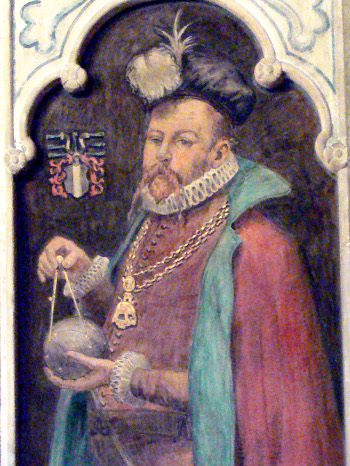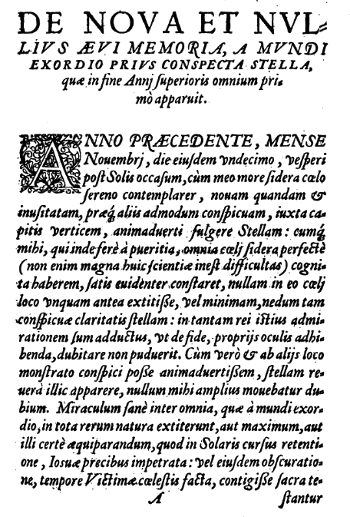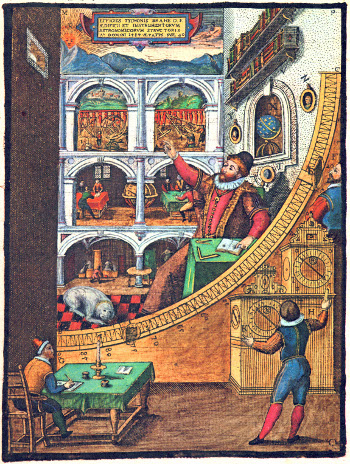Tycho Brahe
August 19, 2011
When I was in
college, I was surprised to find that the non-
scientist fiancée of one of my non-scientist friends, a
journalism student, knew about
Tycho Brahe. If she were of
Danish heritage, I would have understood, since Tycho was a Dane; but she was
Italian.
This was as surprising to me as when I heard two young students on a bus discuss the
periodic table, not in the context of a
homework problem, but in casual conversation. Those were the days before
Madison Avenue started mining the periodic table for
brand names, such as
tungsten for a
personal digital assistant (PDA),
platinum for
credit cards, and
oxygen for a
cable television network. Science has trickled down, somewhat, to the masses.

Tycho Brahe portrait in Copenhagen City Hall.
Tycho is holding a celestial sphere, studded with stars, in his left hand, and a geometrical compass in his right. A detective would infer that he was right handed.
(Detail of photo by Christian Bickel, via Wikimedia Commons))
Tycho was born on December 14, 1546, in
Scania, which was then a part of
Denmark. Since I mentioned the periodic table, it's interesting to note that the element,
scandium, was named for that region. Scandia was the
Latin name for Scandinavia.[1] Tycho became interested in
astronomy when he witnessed the
solar eclipse of August 21, 1560 at age thirteen.
Tycho was quite the scholar, having attended the Universities of
Copenhagen,
Leipzig,
Wittenberg,
Rostock and
Basel. Having a wealthy family certainly helped his college experience, and the same is true even today. While at Leipzig he independently started his astronomical studies, and he found that prior observations were not that
precise or accurate. To address this problem, he designed his own
instruments.[2-3]
While at the University of Rostock, Tycho
dueled a fellow student over the question of who was the better
mathematician. Today, this question would be settled by
GRE scores or dueling
proofs. Instead, they fought with
swords, and Tycho was left with a scarred nose that he camouflaged in later life with a silver-copper
prosthesis. We are, of course, reminded of the silver tongue prosthesis of Jebediah Springfield/Hans Sprungfeld in an
episode of the
Simpsons. I'm reminded, also, of the first meeting between
Joseph Weinberg and
Julian Schwinger.[4]
Tycho's astronomical fame came as a result of his observation and interpretation of the
Supernova of 1572, which is also called Tycho's
supernova. This supernova in
Cassiopeia, visible by the naked eye between early November, 1572, through 1574, was one of only eight historical naked eye supernovae. Tycho published his observations, along with those of other astronomers, in his book, De nova et nullius aevi memoria prius visa stella (Concerning the New Star, never before seen in the life or memory of anyone), published in 1573.[5]

A page from Tycho's, "De nova et nullius aevi memoria prius visa stella."
The first sentence reads (my translation), "The prior year, in the month of November, the eleventh day of the same, on the evening after sunset, as I contemplated the stars upon the serene heavens, there was an unusual star, more conspicuous in its brilliance than others, directly overhead."
(Via Archive.org)
Tycho's observation of this supernova was an important event in the history of astronomy, since it established that what was observed was not an
atmospheric phenomenon, but a distant
star. This demonstrated that the
sphere of fixed stars was neither immutable nor perfect. It was not as divine as thought. This was about as far as Tycho's "
blasphemy" went, since he never accepted the
heliocentric theory of
Copernicus. Tycho's
cosmology kept the
Earth at the center of the
universe. The
Sun and
Moon revolved around the Earth, and the
planets revolved around the Sun.
Tycho's reason for keeping the Earth at the center of the universe was the idea that all bodies would fall (
gravitate) to the center of the universe, and everything obviously fell to Earth. He tried to maintain an obvious principle of
physics in the face of his observations. Tycho's world system was published in 1588 in the book, De Mundi Aetherei Recentioribus Phaenomenis (On Some New Phenomena of the Celestial World).[3]
Tycho's fame grew, and he was offered many positions outside Denmark. The king of Denmark, however, offered Tycho considerable incentives to remain in Denmark. Tycho was given the island of
Ven and the income of a number of estates. On Ven, Tycho built a large scale scientific research enterprise. It was the first
government research laboratory in the western world, and its construction cost about 5% of Denmark's
gross national product.[3]
The island, Ven, is about 4.5 x 2.4
kilometers in size. On Ven, Tycho constructed an observatory, named
Uraniborg, that included instruments below ground to shield them from the wind and other atmospheric effects. Uraniborg was precisely orientated in a north-south direction. One way to ensure publication of your works is to have your own press. Tycho went as far as to have his own paper mill.[2-3]
Not only was astronomy practiced in Uraniborg, but also
alchemy. A basement laboratory had sixteen
furnaces, and the main purpose of the alchemy laboratory was the synthesis of
pharmaceuticals. Tycho saw a parallel between astronomy and alchemy. In a 1588 letter, he wrote,[3]
"It is important to know that the seven planets in the heavens correspond to the seven metals on earth and the seven most important organs in man. All these things had been so finely and harmonically arranged in relation to each other, that they seemed almost to have the same function, type and nature."

Tycho's Mural Quadrant
This instrument was used to measure the altitude of celestial objects when they passed the southern meridian plane (culminated).
The assistant in the lower right was the timekeeper.
Alchemical works can be seen in the background.
(Via Wikimedia Commons)
Tycho Brahe died on October 24, 1601, probably from
uremia brought about by an acute
bladder infection. There's still enough interest in Tycho that his body was
exhumed at the end of 2010 for a more careful analysis of the cause of death.[6-7] There may have been complications from
mercury poisoning through medications he may have taken for his condition. Results of these studies are still pending.
Tycho's greatest legacy is most likely his permitting
Johannes Kepler to use his data. Kepler showed that the orbit of
Mars is
elliptical, and he developed his
three laws of planetary motion.
References:
- The present price for scandium is about $15 per gram, or $465 per troy ounce. Not exactly in the gold range ($1,700 per troy ounce), but still quite respectable.
- Sherman J. Suter, "Tycho's Island," Science, vol. 333, no. 6038 (July 1, 2011), p. 40.
- Tycho Brahe Museum Web Site.
- K. A. Milton, "Julian Schwinger: Nuclear Physics, the Radiation Laboratory, Renormalized QED, Source Theory, and Beyond," Physics in Perspective, vol. 9 (2007), pp. 70-114; also available from the arXiv Preprint Server, October 9, 2006, here.
- Tychonis Brahe, "De nova et nullius aevi memoria prius visa stella, iam pridem anno a nato Christo 1572, mense Novembri primum conspecta, contemplatio mathematica," via Archive.org.
- Scientists exhume body of famed 16th century astronomer Tycho Brahe to finally solve murder mystery, Daily Mail (UK), November 15, 2010.
- David Hannah, "Danish astronomer Tycho Brahe's body exhumed in Prague," BBC, November 15, 2010.
Permanent Link to this article
Linked Keywords: College; scientist; fiancée; journalism; Tycho Brahe; Danish heritage; Italian; periodic table; homework; Madison Avenue; brand name; tungsten; personal digital assistant; platinum; credit card; oxygen; cable television network; Copenhagen; Christian Bickel; Wikimedia Commons; Scania; Denmark; scandium; Latin; astronomy; solar eclipse of August 21, 1560; University of Copenhagen; University of Leipzig; University of Wittenberg; University of Rostock; University of Basel; precise; accurate; scientific instrument; duel; mathematician; Graduate Record Examination; GRE; mathematical proof; sword; prosthesis; Lisa the Iconoclast; Simpsons; Joseph Weinberg; Julian Schwinger; Supernova of 1572; supernova; Cassiopeia; Archive.org; atmospheric; star; sphere of fixed stars; blasphemy; heliocentric theory; Copernicus; cosmology; Earth; universe; Sun; Moon; planet; gravitation; physics; Ven; government research laboratory; gross national product; kilometer; Uraniborg; alchemy; furnace; pharmaceutical; culminate; Wikimedia Commons; uremia; bladder infection; exhumation; mercury poisoning; Johannes Kepler; Mars; elliptical; Kepler's laws of planetary motion.